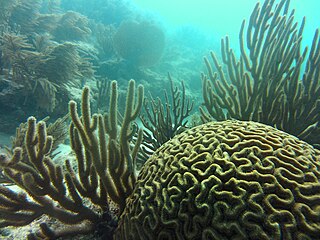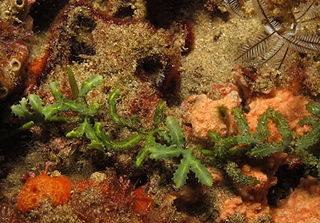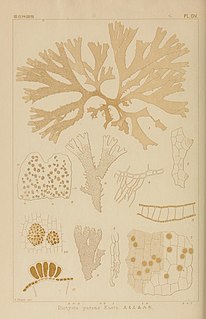
Caulerpa racemosa is a species of edible green alga, a seaweed in the family Caulerpaceae. It is commonly known as sea grapes and is found in many areas of shallow sea around the world. There are a number of different forms and varieties, and one that appeared in the Mediterranean Sea in 1990, which is giving cause for concern as an invasive species.

Mueller's pearlside or Mueller's bristle-mouth fish, Maurolicus muelleri, a marine hatchetfish of the genus Maurolicus, is found in deep tropical, subtropical and temperate waters of the Pacific Ocean and the Atlantic Ocean, from the surface to depths of 1,500 metres (4,900 ft). Its can grow up to 8 centimetres (3.1 in) at maximum.

Cephalopholis fulva, the coney or the butterfish, is a species of marine ray-finned fish, a grouper from the subfamily Epinephelinae which is in the family Serranidae which also includes the anthias and sea basses. It is found in the western Atlantic. It is associated with reefs and is a quarry species for commercial and recreational fisheries. It can be found in the aquarium trade.

Porites astreoides, commonly known as mustard hill coral or yellow porites, is a colonial species of stony coral in the family Poritidae.

Coastal fish, also called inshore fish or neritic fish, inhabit the sea between the shoreline and the edge of the continental shelf. Since the continental shelf is usually less than 200 metres deep, it follows that pelagic coastal fish are generally epipelagic fish, inhabiting the sunlit epipelagic zone. Coastal fish can be contrasted with oceanic fish or offshore fish, which inhabit the deep seas beyond the continental shelves.

Halimeda tuna is a species of calcareous green seaweed in the order Bryopsidales. It is found on reefs in the Atlantic Ocean, the Indo-Pacific region and the Mediterranean Sea. Halimeda tuna is the type species of the genus Halimeda and the type locality is the Mediterranean Sea. The specific name "tuna" comes from the Taíno language, meaning "cactus" and referring to the resemblance of the thallus to the growth form of an Opuntia cactus.

The seaweed blenny is a species of combtooth blenny found in coral reefs in the western Atlantic Ocean along the coasts of New York, Bermuda, the Bahamas, also in the Gulf of Mexico, south to southern Brazil. This species reaches a length of 8.5 centimetres (3.3 in) TL.

Stypopodium is a genus of thalloid brown alga in the family Dictyotaceae. Members of the genus are found in shallow tropical and subtropical seas around Africa, Pakistan, India, Japan, Indonesia, Australia, Micronesia, the Caribbean, Venezuela, and Brazil.

Siderastrea radians, also known as the lesser starlet coral or the shallow-water starlet coral, is a stony coral in the family Siderastreidae. It is found in shallow parts of the western Atlantic Ocean as small, solid mounds or encrusting sheets.

Pseudodiploria strigosa, the symmetrical brain coral, is a colonial species of stony coral in the family Mussidae. It occurs on reefs in shallow water in the West Atlantic Ocean and Caribbean Sea. It grows slowly and lives to a great age.

Acetabularia caliculus, the umbrella alga, is a species of green alga found in shallow temperate and tropical seas.
Lobophora variegata is a species of small thalloid brown alga which grows intertidally or in shallow water in tropical and warm temperate seas. It has three basic forms, being sometimes ruffled, sometimes reclining and sometimes encrusting, and each form is typically found in a different habitat. This seaweed occurs worldwide. It is the type species of the genus Lobophora, the type locality being the Antilles in the West Indies.
Aplysia morio, the Atlantic black sea hare or sooty sea hare, is a species of sea slug, a marine gastropod mollusk in the family Aplysiidae, the sea hares. It lives in warm waters in the Caribbean Sea and off the south and southeastern coast of the United States, where it feeds on seaweed.

Caulerpa serrulata, commonly known as cactus tree alga or serrated green seaweed, is a species of seaweed in the Caulerpaceae family found in warm marine water environments.

Caulerpa sertularioides, also known as green feather algae, is a species of seaweed in the Caulerpaceae family found in warm water environments.
Cosmocampus elucens is a species of marine fish of the family Syngnathidae. It is found in the western Atlantic, off the U.S. east coast, Bermuda, the Bahamas, the Gulf of Mexico, throughout the Caribbean Sea, and off the coast of Brazil. It lives in seagrass and algae beds, typically at shallow depths, where it can grow to lengths of 15 centimetres (5.9 in). It is expected to feed on small crustaceans, similar to other pipefishes. This species is ovoviviparous, with males carrying eggs and giving birth to live young.

Padina boergesenii, commonly known as the leafy rolled-blade alga, is a species of small brown alga found in the tropical and subtropical western Atlantic Ocean, the Mediterranean Sea, and the Pacific Ocean. This seaweed was named in honour of the Danish botanist and phycologist Frederik Børgesen.
Pseudamphithoides incurvaria is a species of amphipod crustacean in the family Ampithoidae. It is native to shallow water in the tropical western Atlantic Ocean where it creates a home for itself from fragments of the algae on which it feeds. This seaweed contains certain chemicals that are distasteful and protect it from predatory fish.

Dictyota bartayresiana, commonly known as a forded sea tumbleweed, is a species of brown alga found in the tropical western Indo-Pacific region and the Gulf of Mexico. It contains chemicals that are being researched for possible use as antimicrobials, as larvicides and as cytotoxins.
Zanardinia is a monotypic genus of seaweed in the brown algae. The only species, Zanardinia typus, commonly known as penny weed, is native to the northeastern Atlantic Ocean and the Mediterranean Sea.












